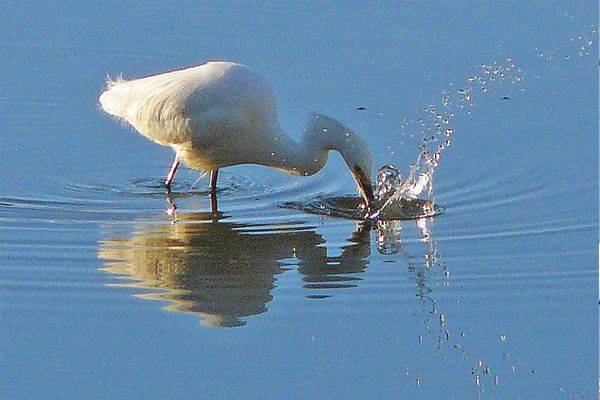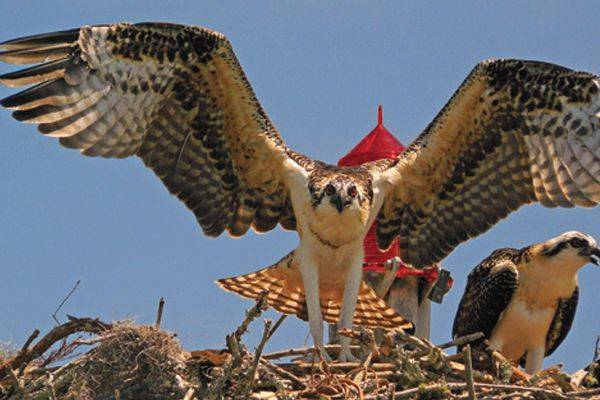By Doug Wakeman
[dropcap]F[/dropcap]ish don’t bite every day. Even on the Apalachicola River, as fabulous as the fishing will often be for stripers, catfish, Largemouth bass, bluegill, trout, and redfish, there will be days when lines never come tight. On those days, you’ll surely find yourself saying “Let’s be grateful for this beauty, and for these gorgeous birds to watch. And let’s be grateful for the biodiversity that makes all this possible.”
If that last part doesn’t sound like you, well, it should. Biodiversity is a big word, but a simple idea: how many different kinds of things — plants, animals, algae, bacteria, etc — are living & growing out here? Ecologists use “species richness” as a measure: how many distinct species are present? The larger the count, the more diverse the system is. Diverse systems are strong systems: they resist stress better. Diverse systems hold onto more of their productivity and bounce back faster when bad conditions occur. That’s true whether it’s short-term stresses like flash floods, or longer-term stresses like climate change. And diversity reinforces itself: diverse plants help produce a wide variety of small critters, which attract a wide variety of predators.
The Apalachicola River region is one of the most species-rich places in all of North America. The huge variety of life here makes the system productive and resilient. It draws the huge variety of predators that we chase with hooks and lines, and those that we just watch as we sit and wait.
Three features help create this variety. First, the Apalachicola River and its wide floodplain are relatively pristine, having been spared much of the destruction that so many rivers suffer. From Georgia to the Bay, it courses 108 miles without a single dam. Second, the watershed extends about 500 miles up the Chattahoochee River and connects the Appalachian Mountains with the Gulf of Mexico. It’s a pathway for migratory birds, and for plants, too. Seeds from upland trees can float down the river or be carried by birds, and take root in places far from their usual homes. Third, the system has landscapes that create “Micro-Climates.” These are small areas where the temperature and humidity may be very unlike those nearby. One example is Steephead Ravines, which can be much wetter and cooler than their surroundings. Such areas provide homes for plants and animals not normally found in these latitudes, making the system more productive and resilient.

What does all this mean to you, the Coastal Angler? First, it means that you have a wide variety of potential targets, and a wide variety of natural bait with which to pursue them. A friend of mine recently caught a Speckled trout, a striper, a Largemouth bass, and a couple of slot-size redfish all in the same small creek just off the main river! Now where else on earth do you find that? (Location revealed upon request, but you’ll have to ask HIM!) And you can net mullet for bait throughout the entire 108 miles of the river. There may not be another river anywhere that can boast both of those opportunities.
Second, there’s a huge variety of gorgeous birds to admire and photograph on those days when nothing will bite. My aging eyes have given up on the small ones to focus on the big ones, but I never lack for beautiful birds to admire or interesting behavior to observe. This is especially true at this time of year when mating, nesting, and nurturing activities are peaking.
The most obvious big flyers I call The Gawky Ones — the herons & egrets — so awkward- looking at times, yet so graceful in flight. And yet, they are such deadly hunters of your favorite baitfish. You can see great blue herons almost anywhere along the river. Great egrets, with their blindingly-white plumage, are less numerous but not rare, especially in the shallow waters of the marshes. Snowy egrets and cattle egrets are less common, but just as brightly-visible. Cruise the smaller creeks, and you can see their more elusive relatives, the night herons (yellow- or black-crowned), the little blue heron, and the occasional Louisiana (tricolored) heron.
Bald eagles are always a thrill to see. They’re common in the lower river and the estuary, and a few can be observed from one end of the river to the other. Some are year-round residents and some are just migrating through, but it’s a rare day on the river that you won’t see a few.
Like the eagles, the black-and-white ospreys are everywhere, but more common in the lower river and the estuary. These may be the most fun of all the big birds, as they build easily-watched nests on channel markers. Ospreys are less skittish than other large birds, so you can get close enough for great pictures without scaring them away. If you’ve got a 200 mm lens (or 8x zoom on a digital) you can take terrific osprey-nest photos.

Most of those birds are here all year, but there are seasonal treats, too. One of these is just arriving and one is just about to depart. Now leaving are our most distinguished-looking winter visitors, the white pelicans. About twice as large as their familiar brown cousins, they are present along the Gulf Coast throughout the winter. They are fond of sandbars in Apalachicola Bay as roosting spots. You’ll see them soaring and gliding in majestic formations over the lower river. It’s always sad to see them depart, but that just means it’s time for the kites to arrive.
Mississippi kites are seen circling over the forested wetlands, but the real treat is the swallow-tailed kites. These black and white raptors with their long forked tails are amazing flyers. They appear out of nowhere, gracefully gliding high and then diving low over the river to grab a butterfly or a dragonfly. They dart and plunge and climb in ways that seem impossible for a bird that size. And then they vanish as suddenly as they appeared. Populations of swallow-tailed kites are greatly reduced these days because of destruction of good nesting habitat. The Apalachicola National Forest is one of their last important strongholds. They’re here from early April until late July, and they provide truly memorable air shows. Although they’re not water birds, there is no better place to see them than the Apalachicola River.
So the next time you’re having one of those fishless days on the river, remember that some of the best experiences on the water come from gazing up rather than down. Set out some live bait just in case, and then grab the binoculars and the camera. Turn your eyes to the sky, and enjoy the shows that our feathered friends provide. And as you do, give thanks for the benefits of biodiversity, and for the uniquely-diverse ecosystem that is the Apalachicola River.
By Doug Wakeman, Senior Policy Analyst for Apalachicola Riverkeeper which is a member- supported non-profit organization dedicated to the conservation and restoration of the Apalachicola River and Bay. Send email to doug@ApalachicolaRiverkeeper.org, or visit us on the web at www.ApalachicolaRiverkeeper.org, or call us at 850-653-8936, or Find Us on Facebook.

